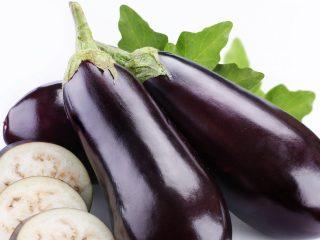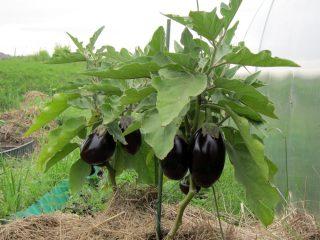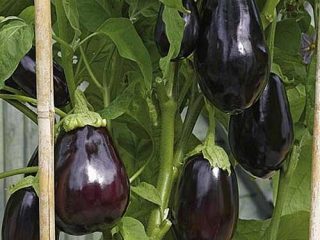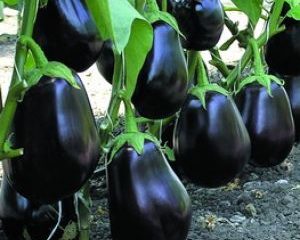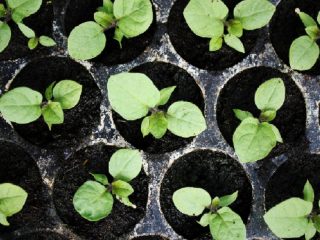Content
The leaves of eggplant seedlings dry out for various reasons. They are mainly associated with disruption of care. For example, these could be errors in soil preparation, irregular watering, or lack of fertilization. Plants suffer from both a lack of lighting and its excess. If you create normal growing conditions, you can avoid this problem.
Why do the leaves of eggplant seedlings dry out?
The reasons for drying, yellowing, and deformation of leaves can be different. As a rule, they are associated with maintenance errors or incorrect soil composition. Drying can also occur due to delays in transplanting seedlings into open ground. The main factors are described below.
Nutritional deficiency
If the seedlings begin to dry out and the leaves turn yellow, this is due to a nutritional deficiency. A deficiency, as a rule, is observed in several elements at once, rather than in one element. You can determine the specific cause by external signs:
- Nitrogen deficiency manifests itself in that the seedlings will dry out and the leaves begin to turn yellow.The tops become light.
- Lack of phosphorus - eggplant seedlings begin to dry out. The foliage curls upward, the tips become pointed.
- Lack of potassium - eggplants grow poorly, the foliage becomes stained, then they begin to dry out and die.
- If there is not enough magnesium, the foliage turns yellow and pale, and part of the surface of the seedling plates also dries out.
Improper watering
If the seedlings begin to dry out, lose their elasticity, and the leaves look weak, this indicates insufficient watering. Eggplants require regular water supply. In the first two months, watering should be done every 2-3 days, and only settled water is used for this. Until the seedlings have sprouted or they are small, it is better to give the liquid from a spray bottle. Then it is poured in a small stream under the root.
It is necessary to ensure that the surface layer of soil remains moderately moist. If the soil has received too much water, stop watering for 5-7 days. Otherwise, eggplant seedlings may also suffer and even die.
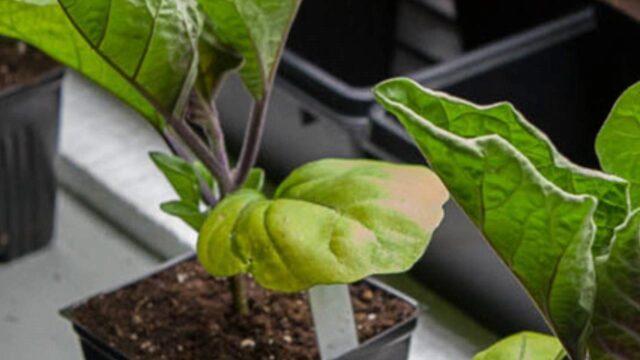
Due to irregular watering, the seedlings will dry out and weaken
Exposure to sunlight
Seedlings need good lighting. But if the seedlings are exposed to the scorching sun for several days in a row, the foliage may begin to dry out. This phenomenon is often due to the following reasons:
- grow crops on the south side;
- when watering, pour water directly over the leaves during the day (it is better to do this in the evening or early morning);
- The plants are placed under a phytolamp, without sun penetration, and then abruptly planted in open ground under the sun's rays.
Affected by diseases
The foliage of eggplant seedlings begins to dry out when affected by diseases. Often the cause is fusarium. Fungal spores come from the soil and attack weak seedlings. The main symptoms are:
- developmental delay;
- the roots turn pink;
- a brown coating appears on the stems;
- the foliage of eggplant seedlings dries at the edges and turns yellow;
- The cotyledon (first two) leaves are curled into tubes.
Another possible cause is late blight. Because of it, the seedlings will dry out and brown spots will appear on the foliage. The disease affects the lower parts of eggplants, but then the whole plant begins to hurt. If left untreated, it will quickly turn black and die.
Also, the seedlings will dry out due to verticillium. This is a fungal infection that leads to yellowing of the veins and the appearance of mottled spots. The eggplant will dry out, the foliage will begin to curl, and the cut stem will turn brown.
Early planting in the soil
If transplanted early into open ground, eggplant seedlings may also dry out. This is a stress response associated with sudden temperature changes. The plants are sensitive, they develop normally at a temperature of 22-27 degrees.
Therefore, transplanting seedlings should be planned no earlier than mid-May. Moreover, in the Urals, Siberia and northern regions it can only be grown in greenhouses.
If the lower leaves dry out
If the lower foliage begins to dry out and turn yellow, this indicates a lack of nutrients.At first, nitrogen compounds are especially important for plants. Therefore, they need to be given urea, or better yet, a complex fertilizer. Even if the yellow foliage flies off, the seedlings will subsequently grow normally.
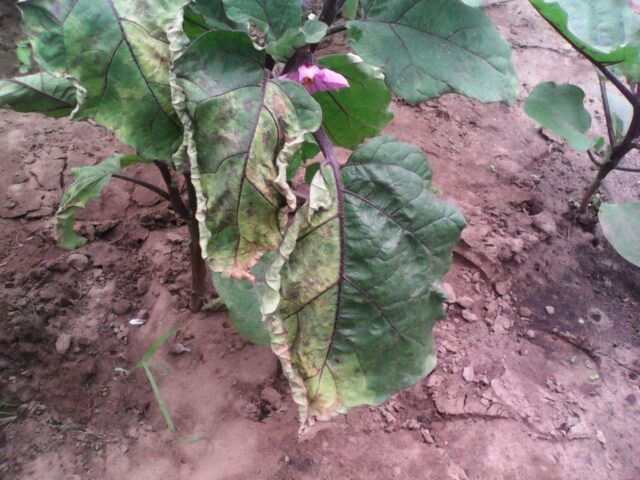
If the lower leaves dry out and turn yellow, the reason is due to a lack of nitrogen.
If the soil is fertile and fertilizing is applied regularly, it is necessary to feel the surface layer of the soil. If it is almost dry, the reason is most likely due to a lack of moisture. Then the foliage will wither and lose elasticity, but without yellowing.
If the top leaves dry out
If the top leaves of eggplant seedlings begin to dry out, the reason is most often due to a lack of nitrogen. This can be determined by a number of external signs:
- weakening of growth or complete stop in development;
- small foliage and stems;
- leaves are pale and lose their shine;
- The green color changes to yellow and lighter.
In this case, it is necessary to add ammonium nitrate or urea. If the signs are too pronounced, foliar fertilizing with these nitrogen fertilizers is carried out.
If the leaves dry out and become deformed
If the seedlings begin to dry out and become deformed, this may be due to the same reasons described above. Often this phenomenon is observed due to lack of light.
Plant seeds are sown in February, when there is not enough natural light. Even if you place containers on southern windows, you will need to use fluorescent lamps or phytolamps. Light sources must be hung at a height of 50-60 cm. The backlight is turned on daily in the morning and evening - for a total of 4-5 hours.
Deformation may also be associated with pest invasion. If your eggplant seedlings begin to dry out, it is important to carefully inspect them using a flashlight.If cobwebs are found on the underside of the leaves, these are signs of spider mites. A cluster of aphids may also be detected on the shoots. In both cases, it is necessary to treat with folk remedies or insecticides.
What to do if eggplant seedlings dry out
To prevent seedlings from drying out, it is necessary to provide them with proper care. One of the important rules is timely watering. During the first month, water is given three times a week in a “every other day” mode. To ensure that not only the soil, but also the air is sufficiently humid, the containers are covered with glass or film with holes. The shelter must be cleaned regularly for ventilation.
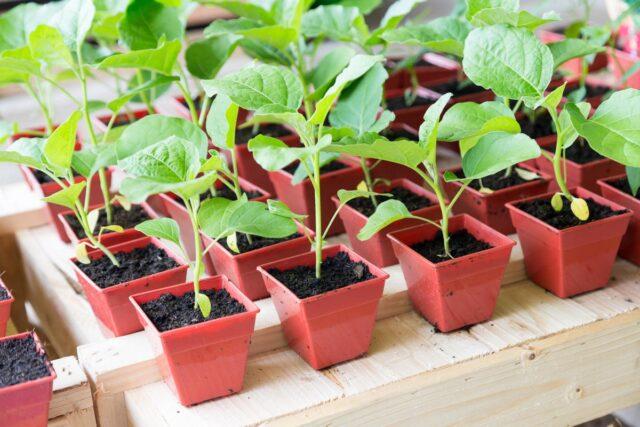
Before transplanting into the ground, seedlings are fed three times.
To prevent plants from drying out, they must be fertilized regularly. You can use the following fertilizers:
- infusion of mullein or chicken droppings;
- complex composition, for example, “Ideal”;
- potassium sulfate;
- superphosphate;
- ammonium nitrate;
- urea.
Fertilizers for eggplants are applied several times. Before picking, pour in infusion of mullein, diluted 10 times, or chicken droppings (20 times). Instead of organic matter, you can feed with ammonium nitrate (5 g per 10 l), superphosphate (15 g) and potassium sulfate (20 g).
After picking, when the eggplant seedlings produce 2-3 leaves, add a complex composition, for example, “Kristalon”. A few days before transferring to open ground, mineral fertilizers are used again - potassium salt (30 g per 10 l) and superphosphate (50 g per 10 l). To prevent eggplant seedlings from drying out, all preparations are given exactly according to the instructions, since overfeeding will lead to a deterioration in the composition and structure of the soil.
A few days after transfer to the greenhouse or beds, preventive treatment with fungicides is carried out. To prevent the foliage from drying out, use the following preparations:
- "Fitosporin";
- "Bordeaux mixture";
- "Skor";
- "Maksim".
If insects are detected, treat with insecticides:
- "Aktara";
- "Karate";
- "Fufanon";
- "Biotlin."
Preventive measures
To prevent the seedlings from drying out, it is necessary to create normal growing conditions, as well as ensure the correct planting time. Seeds are sown 80 days before transferring to the ground. In most regions, work should begin in the last ten days of February or early March. As for transplanting to the beds, it is planned for the middle - second half of May. You can transfer it to the greenhouse a week earlier.
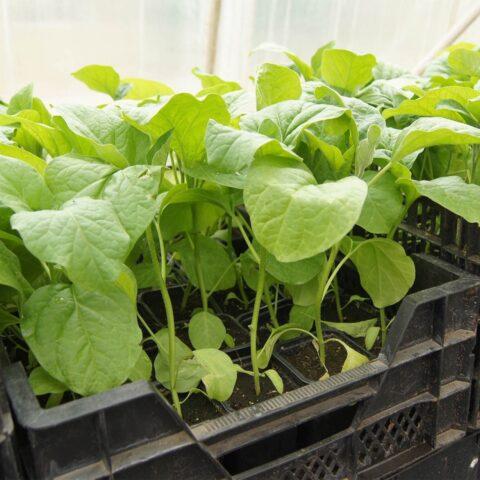
Seedlings are transplanted into open ground in the second half of May or early June
Eggplants will not dry out if the soil is properly prepared. The soil can be purchased at the store or made independently based on turf soil, compost, peat and sand in a ratio of 2:1:1:1. The mixture is first disinfected with potassium permanganate (1 g per 1 liter) or kept in the freezer for several days.
While growing seedlings, provide regular watering and a consistently high temperature in the range of 24-27 degrees. You will need to organize good lighting and apply fertilizer at least three times before transplanting into the ground.
Conclusion
Leaves of eggplant seedlings dry out, usually due to violation of growing rules. Seedlings grow well at a temperature of 23-27 degrees, in conditions of high humidity and sufficient lighting. It is important to take into account the timing of sowing seeds and transplanting into open ground. It is important to harden off the seedlings two weeks before.Thanks to this, it will not dry out, and will also become immune to temperature changes.


